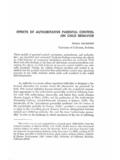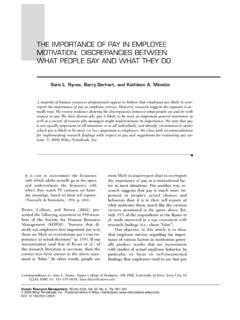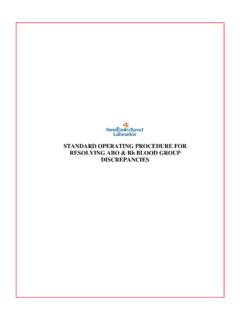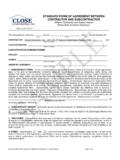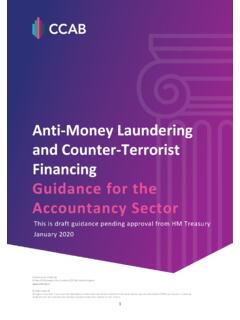Transcription of Self-Discrepancy: A Theory Relating Self and Affect
1 Psycholo0cal Review Copyright 1987 by the American Psychological Association, Inc. 1987, Vol. 94, No. 3, 319-340 0033-295X/87/$ Self-Discrepancy: A Theory Relating Self and Affect E. Tory Higgins New York University This article presents a Theory of how different types of discrepancies between self-state representa- tions are related to different kinds of emotional vulnerabilities. One domain of the self (actual; ideal; ought) and one standpoint on the self (own; significant other) constitute each type of self-state representation.
2 It is proposed that different types of self- discrepancies represent different types of negative psychological situations that are associated with different kinds of discomfort. Discrepan- cies between the actual/own self-state ( , the self-concept) and ideal self-states ( , representations of an individual's beliefs about his or her own or a sitmifieant other's hopes, wishes, or aspirations for the individual) signify the absence of positive outcomes, which is associated with dejection-related emotions ( , disappointment, dissatisfaction, sadness).
3 In contrast, discrepancies between the ac- tual/own self-state and ought self-states ( , representations of an individual's beliefs about his or her own or a significant other's beliefs about the individual's duties, responsibilities, or obligations) signify the presence of negative outcomes, which is associated with agitation-related emotions ( , fear, threat, restlessness). Differences in both the relative magnitude and the accessibility of individu- als' available types of self- discrepancies are predicted to be related to differences in the kinds of discomfort people are likely to experience.
4 Correlational and experimental evidence supports the predictions of the model. Differences between self-discrepancy Theory and (a) other theories of in- compatible self-beliefs and (b) actual self negativity ( , low self-esteem) are discussed. The notion that people who hold conflicting or incompatible beliefs are likely to experience discomfort has had a long history in psychology. In social psychology, for example, various early theories proposed a relation between discomfort and specific kinds of"inconsistency" among a person's beliefs ( , Abelson & Rosenberg, 1958; Festinger, 1957; Heider, 1958; McGuire, 1968; Newcomb, 1968; Osgood & Tannenbaum, 1955).
5 And various classic theories Relating self and Affect proposed that self-conflicts or self-inconsistencies produce emotional prob- lems ( , Adler, 1964; Allport, 1955; Cooley, 1902/1964; Freud, 1923/1961; Homey, 1939, 1946; James, 1890/1948; Lecky, 1961; Mead, 1934; Rogers, 1961). The Theory to be pre- sented here, self-discrepancy Theory , has close ties to this histor- ical tradition. But its construction was guided by a distinct set of aims: (a) to distinguish among different kinds of discomfort that people holding incompatible beliefs may experience, (b) to relate different kinds of emotional vulnerabilities systemati- cally to different types of discrepancies that people may possess among their self-beliefs, and (c) to consider the role of both the This research was supported by Grant MH 39429 from the National Institute of Mental Health.
6 I am grateful for financial support provided by the John D. and Catherine T. MacArthur Foundation and by the Alfred P. Sloan Foundation. I would like to thank Diane Ruble, Yaacov Trope, Robin Wells, and Henri Zukier for their helpful comments and suggestions on earlier ver- sions of this article. The final revision of this article was prepared while I was a Fellow at the Center for Advanced Study in the Behavioral Sci- ences. Correspondence concerning this article should be addressed to E. Tory Higgins, Department of Psychology, New York University, 6 Wash- ington Place, 7th Floor, New York, New York 10003.
7 319 availability and the accessibility of different discrepancies peo- ple may possess in determining the kind of discomfort they are most likely to suffer. Although many different types of belief incompatibility have been described in the literature--for example, dissonance ( , Aronson, 1969; Festinger, 1957), imbalance ( , Heider, 1958; Newcomb, 1968), incongruity ( , Osgood & Tannenbaum, 1955), and self-inconsistency ( , Epstein, 1980; Lecky, 1961)--the emotional consequences have typically been de- scribed only in very general terms, such as tension, unpleasant- ness, pressure, conflict, stress, or discomfort.
8 And yet it is clear from the general psychological literature that distinct emotional clusters or syndromes exist. From factor analysis, cluster analy- sis, and circular scaling, researchers have reported that dissatis- faction, feeling discouraged, feeling pitiful, feeling sad, feeling gloomy, and feeling miserable tend to cluster ( , Cattell, 1973; DeRivera, 1977; Ewert, 1970; Kemper, 1978; Zuckerman & Lubin, 1965), whereas guilt, anxiety, worry, fear, feeling tense, feeling alarmed, and feeling threatened form another cluster (Ausubel, 1955; Bibring, 1953; Cattell, 1973; DeRivera, 1977; Ewert, 1970; Kemper, 1978; Russell, 1980.)
9 Zuckerman & Lubin, 1965). This basic distinction between dejection-related emotions and agitation-related emotions has also been made frequently in the clinical literature, not only to distinguish be- tween depression and anxiety but also to distinguish between different kinds of depression (see, , Beck, 1967, 1983; Cam- eron, 1963; White; 1964). Thus previous theories of belief incompatibility are limited in that they do not consider that distinct kinds of discomfort may be associated with belief incompatibility. These theories, then, cannot predict which kind of discomfort or emotional problem will be induced by a particular type of belief incom- 320 E.
10 TORY HIGGINS patibility. In addition, the possibility does not arise that chronic individual differences in type of belief incompatibility may be related to individual differences in emotional vulnerability. In- deed, among theories concerned with self-evaluation, theories of vulnerability to generally positive or negative emotions are relatively common, such as theories of achievement motivation ( , Atkinson, 1964; McClelland, 1961), but theories of vul- nerability to different kinds of negative emotions are rare. And those that have been proposed tend to describe emotional vul- nerability in terms of problem areas, such as interpersonal de- pendency problems versus achievement or self-efficacy prob- lems, rather than to relate emotional vulnerability to specific types of incompatible beliefs ( , Beck, 1983; Blatt, D'Affiitti, & Quinlan, 1976).
